Effective quest design in multiplayer fantasy adventure games enhances player engagement and satisfaction. Key strategies include creating engaging narratives, balancing difficulty, fostering collaboration, and providing meaningful rewards. Popular quest types like cooperative quests, competitive challenges, and narrative-driven missions cater to diverse player preferences. Additionally, understanding pacing and avoiding common pitfalls can significantly improve the overall gaming experience.

What are the key principles of quest design in multiplayer fantasy adventure games?
Effective quest design in multiplayer fantasy adventure games hinges on several key principles. These include creating engaging narratives, balancing difficulty, fostering player collaboration, and ensuring meaningful rewards.
Engaging narratives draw players into the game world, making them feel invested. Balancing difficulty keeps challenges appropriate for varying skill levels, preventing frustration or boredom. Fostering collaboration encourages teamwork, enhancing social interaction and player enjoyment. Meaningful rewards provide motivation, ensuring players feel their efforts are valued.
Incorporating these principles not only enhances gameplay but also strengthens player retention and satisfaction.
How do player motivations influence quest design?
Player motivations significantly shape quest design by tailoring experiences to their desires. Understanding whether players seek exploration, challenge, or social interaction allows designers to create engaging and relevant quests.
For instance, players motivated by exploration benefit from open-world quests that encourage discovery. Conversely, those seeking challenge may prefer quests with difficult enemies or intricate puzzles. Socially motivated players thrive on cooperative quests that require teamwork.
These motivations inform the pacing, complexity, and narrative depth of quests, ensuring they resonate with diverse player preferences. Ultimately, aligning quest design with player motivations enhances overall satisfaction and retention in multiplayer fantasy adventure games.
What role does narrative play in quest structure?
Narrative plays a crucial role in quest structure by enhancing player engagement and immersion. It establishes context, motivates players, and drives emotional investment in the game world. A well-crafted narrative guides players through challenges while providing meaningful choices and consequences. This depth transforms quests from mere tasks into memorable experiences, fostering a connection between players and the game’s story. Ultimately, integrating narrative elements into quest design enriches gameplay and encourages exploration within the fantasy setting.
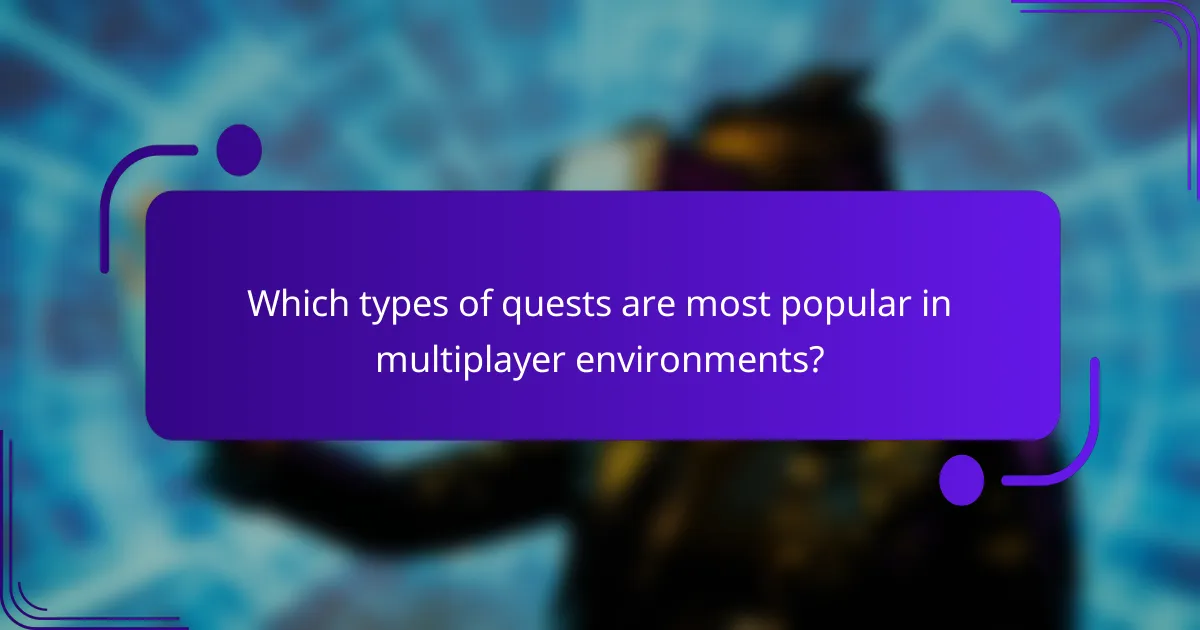
Which types of quests are most popular in multiplayer environments?
Cooperative quests, competitive challenges, and narrative-driven missions are the most popular types in multiplayer environments. Cooperative quests encourage teamwork and collaboration among players. Competitive challenges foster rivalry and skill-based engagement. Narrative-driven missions immerse players in rich storytelling, enhancing the overall experience. Each type appeals to different player preferences, ensuring diverse gameplay.
How do fetch quests enhance player engagement?
Fetch quests enhance player engagement by providing structured tasks that promote exploration and interaction. They encourage players to immerse themselves in the game world, fostering a sense of achievement through completion. These quests often introduce unique rewards, which can enhance the overall gameplay experience. Additionally, they create opportunities for social interaction among players, further strengthening community bonds. Engaging fetch quests can lead to increased playtime and player retention, making them a vital strategy in quest design for multiplayer fantasy adventure games.
What are the benefits of cooperative quests?
Cooperative quests enhance player engagement, foster teamwork, and provide unique rewards. They encourage social interaction, allowing players to strategize and collaborate effectively. This shared experience can lead to stronger community bonds and increased game longevity. Additionally, cooperative quests often introduce challenges that require varied skills, promoting diverse gameplay styles.
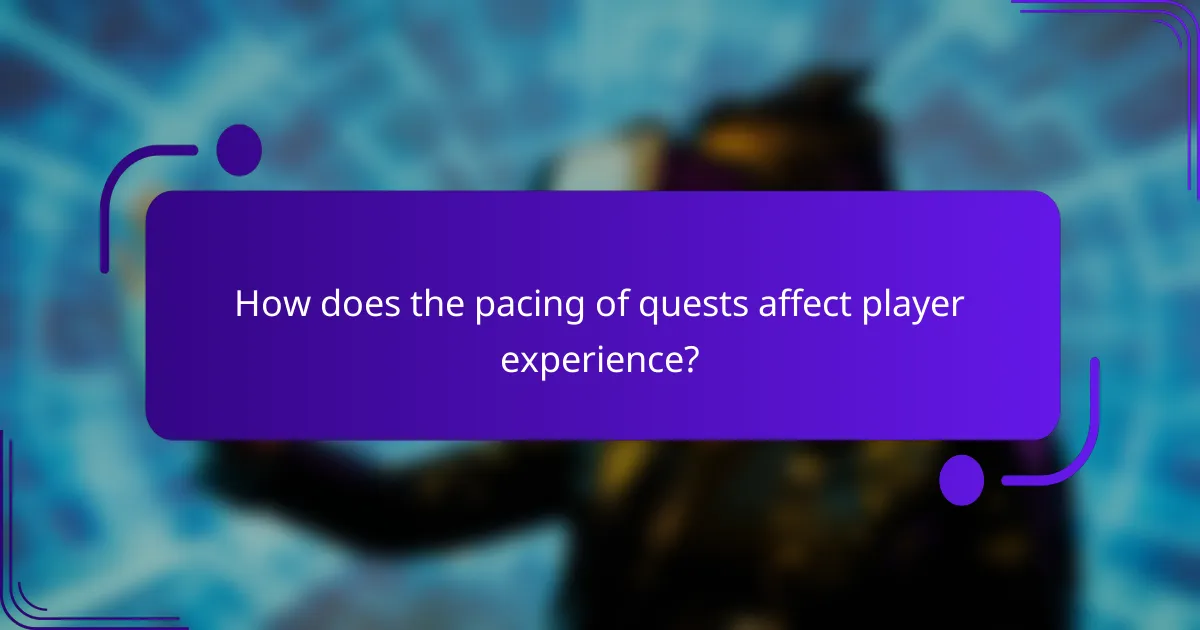
How does the pacing of quests affect player experience?
The pacing of quests significantly influences player experience by affecting engagement and satisfaction. Proper pacing maintains player interest, balancing challenge and reward. Slow pacing may lead to boredom, while fast pacing can cause frustration. Effective quest design strategically spaces challenges, allowing players to absorb narratives and develop skills. This balance enhances overall immersion and enjoyment in multiplayer fantasy adventure games.
What strategies can be used to balance quest difficulty?
To balance quest difficulty, designers can implement adaptive scaling, varied challenge types, and player feedback integration. Adaptive scaling adjusts quest difficulty based on player performance, ensuring engagement without frustration. Varied challenge types, such as puzzles, combat, and exploration, cater to diverse player skills. Player feedback integration allows real-time adjustments, enhancing player experience and satisfaction.
How can time-sensitive quests impact gameplay dynamics?
Time-sensitive quests significantly enhance gameplay dynamics by creating urgency and encouraging player engagement. Players must prioritize tasks, which leads to strategic decision-making. This design element fosters collaboration in multiplayer settings, as players often rely on teamwork to complete objectives within tight timeframes. Additionally, the pressure of deadlines can heighten excitement and immersion, making the gaming experience more memorable. Balancing the difficulty of these quests is crucial; overly challenging tasks can frustrate players, while manageable challenges can lead to satisfaction and a sense of accomplishment.
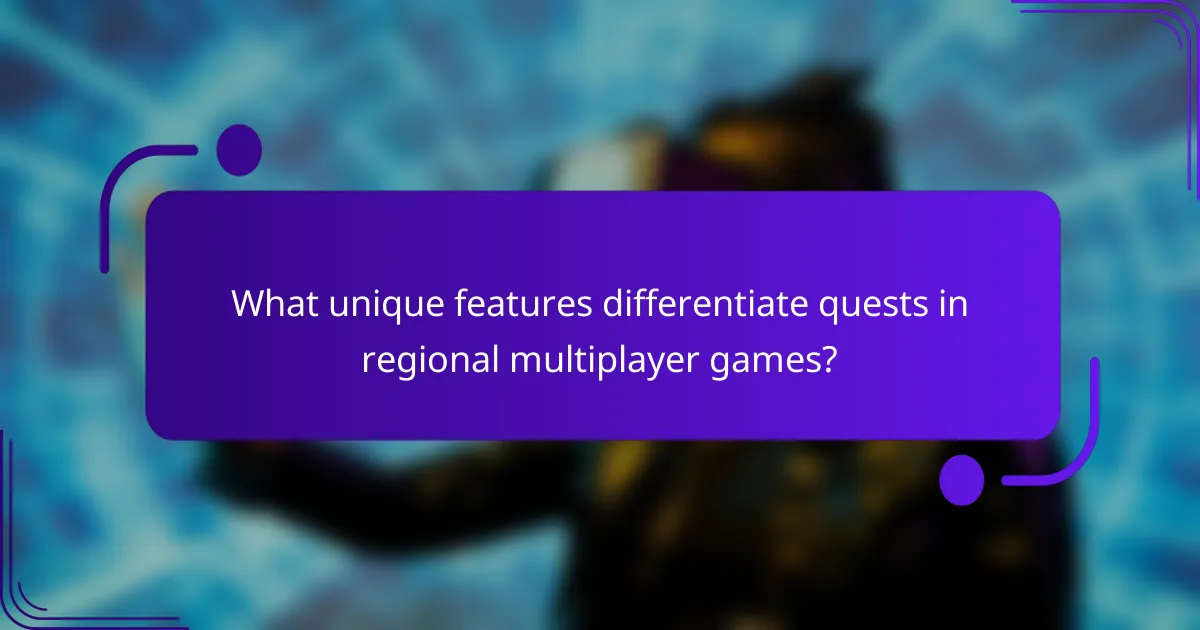
What unique features differentiate quests in regional multiplayer games?
Unique features that differentiate quests in regional multiplayer games include localized narratives, culturally relevant rewards, and community-driven objectives. These elements enhance player engagement by reflecting regional lore and fostering collaboration among players. For example, quests may involve solving local mysteries or celebrating regional festivals, making the gameplay experience more immersive and relatable. Additionally, unique attributes like regional language options and tailored challenges further differentiate these quests, appealing to diverse player bases.
How do cultural narratives shape quest themes in different regions?
Cultural narratives significantly influence quest themes in various regions by shaping storytelling elements and player motivations. These narratives inform the design of quests, reflecting local myths, traditions, and values. For example, quests in Eastern cultures often emphasize harmony and community, while Western narratives might focus on individual heroism and personal growth.
Regional storytelling techniques also affect quest structure. In some cultures, quests may involve moral dilemmas rooted in folklore, while others may prioritize action and adventure. The incorporation of local legends can enhance immersion, making quests more relatable to players.
Moreover, cultural diversity enriches multiplayer fantasy adventure games by providing varied experiences. This diversity allows players to engage with quests that resonate with their backgrounds, fostering a deeper connection to the game world.
In summary, cultural narratives shape quest themes by influencing storytelling, structure, and player engagement, creating unique experiences across different regions.
What are some examples of region-specific quest mechanics?
Region-specific quest mechanics enhance player engagement by incorporating local culture and geography. Examples include environmental puzzles unique to a region, faction-based quests that reflect local politics, and lore-driven tasks tied to regional history. These mechanics create immersive experiences that resonate with players, promoting exploration and interaction.
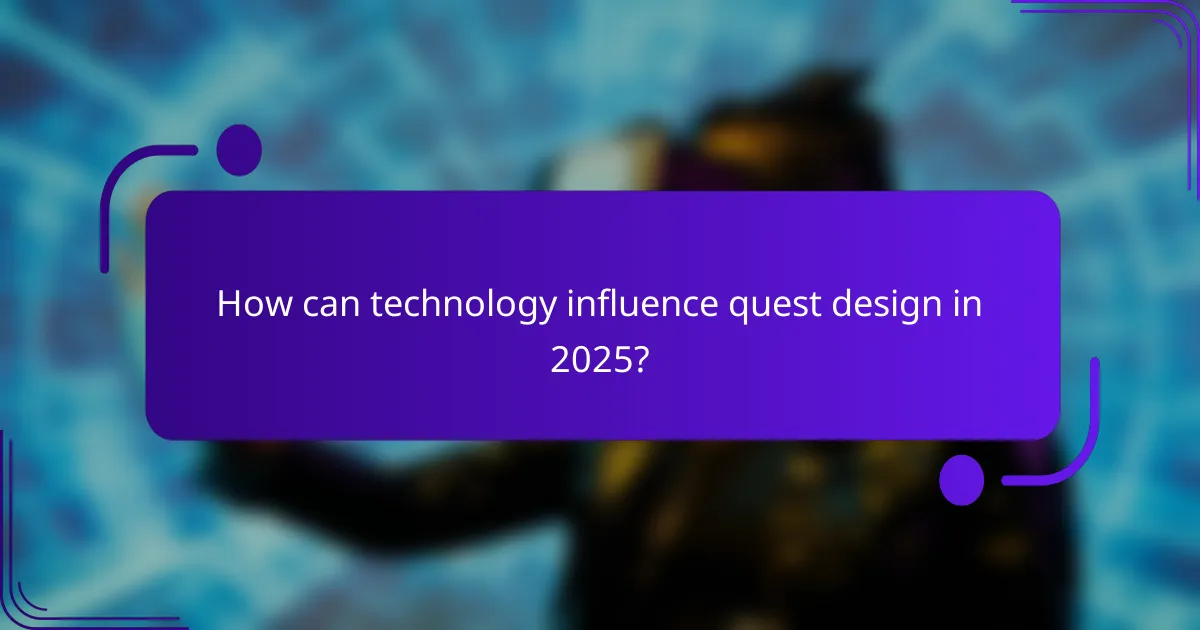
How can technology influence quest design in 2025?
Technology will significantly enhance quest design in multiplayer fantasy adventure games by 2025 through immersive experiences, AI-driven narratives, and dynamic environments. Advanced virtual reality tools will allow players to engage in more realistic worlds, enhancing emotional connections to quests. Artificial intelligence will create adaptive storylines, personalizing challenges based on player behavior and choices. Additionally, cloud gaming will enable seamless updates and expansions, providing fresh content and maintaining player interest. These innovations will transform how quests are structured, focusing on interactivity and player agency.
What role do AI and procedural generation play in quest creation?
AI and procedural generation significantly enhance quest creation in multiplayer fantasy adventure games. They enable dynamic storytelling and personalized experiences, adapting quests based on player behavior and preferences. Procedural generation allows for diverse environments and challenges, ensuring each gameplay experience feels unique. This technology can streamline the design process, reducing development time while maintaining high-quality content. AI can analyze player interactions, modifying quests in real-time to keep engagement levels high.
How can cross-platform play affect quest design choices?
Cross-platform play can significantly enhance quest design by promoting inclusivity and broadening player engagement. It encourages developers to create quests that cater to diverse player skill levels and play styles.
Designers must consider varying input methods across platforms, ensuring quests remain accessible regardless of whether players use a controller, keyboard, or touch interface. This necessitates intuitive quest mechanics that can be easily understood and executed by all players.
Additionally, cross-platform play fosters community interaction, prompting quests that require collaboration between players on different devices. This can lead to innovative quest structures that emphasize teamwork and social dynamics.
Lastly, balancing challenges for a mixed player base is crucial. Developers must design quests that are challenging yet achievable for all participants, maintaining a fair and enjoyable experience.
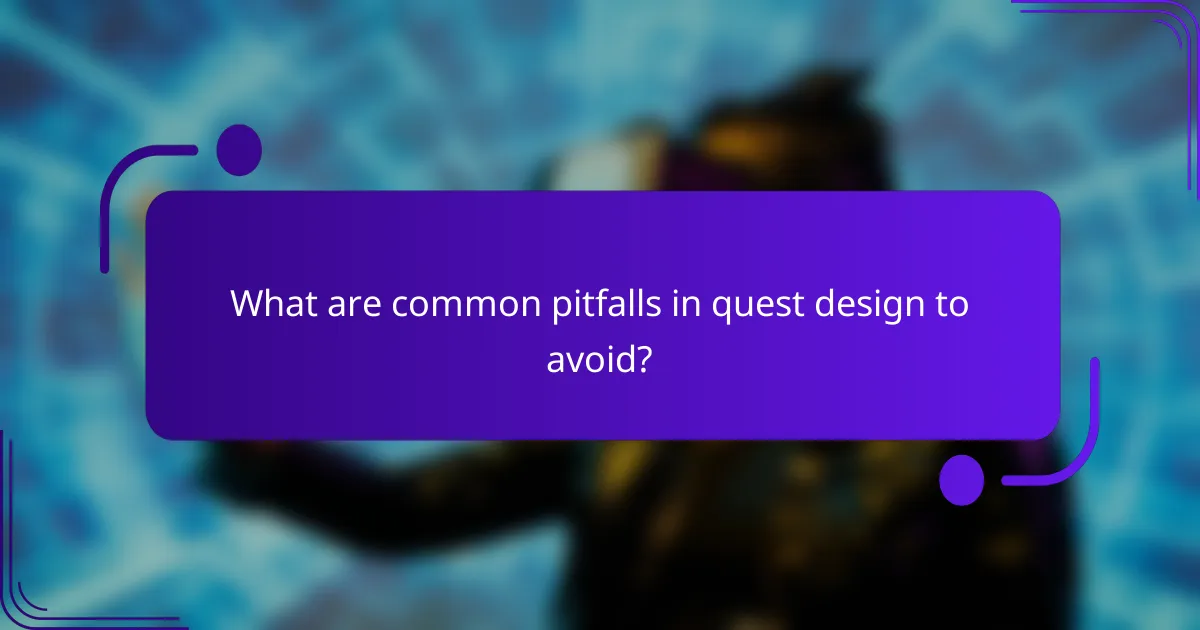
What are common pitfalls in quest design to avoid?
Common pitfalls in quest design include lack of clarity, poor pacing, and insufficient player agency. These issues can frustrate players and diminish their engagement.
One major pitfall is vague objectives, which can lead to confusion about the quest’s goals. Players benefit from clear instructions and defined outcomes.
Another frequent mistake is uneven pacing. Quests that are too short may feel unsatisfying, while overly lengthy ones can lead to player fatigue. Balancing these elements is crucial for maintaining interest.
Lastly, limiting player choices can hinder the immersive experience. Allowing players to make meaningful decisions enhances their connection to the game world and its narrative.
How do repetitive quests affect player retention?
Repetitive quests can negatively impact player retention by causing boredom and reducing engagement. When players encounter the same tasks repeatedly, it diminishes their sense of achievement and exploration. This can lead to frustration and a decline in overall enjoyment, ultimately resulting in players abandoning the game. Effective quest design should introduce variety and meaningful challenges to maintain player interest and promote long-term engagement.
What mistakes should designers avoid when crafting multiplayer quests?
Designers should avoid common pitfalls like lack of clarity, poor pacing, and insufficient player agency. These mistakes can hinder player engagement and disrupt the quest experience.
Firstly, unclear objectives can confuse players, leading to frustration. Ensure that goals are well-defined and easy to understand. Secondly, pacing is crucial; quests that are too long or short can impact enjoyment. Balance challenges and rewards to maintain interest.
Lastly, neglecting player agency can diminish the sense of immersion. Allow players to make meaningful choices that influence the quest outcome. By steering clear of these mistakes, designers can create more engaging multiplayer quests.
What best practices can enhance quest design effectiveness?
Effective quest design in multiplayer fantasy adventure games can be enhanced through several best practices. Focus on clear objectives, engaging narratives, and player agency to create immersive experiences.
1. Define clear objectives: Ensure quests have specific goals that guide players through the experience.
2. Incorporate engaging narratives: Develop compelling storylines that resonate with players and enhance emotional investment.
3. Foster player agency: Allow players to make meaningful choices that affect outcomes, increasing their connection to the game.
4. Balance challenge and reward: Design quests that provide appropriate difficulty levels, ensuring players feel rewarded for their efforts.
5. Use feedback loops: Implement systems that provide players with immediate feedback, reinforcing their actions and decisions.
6. Encourage collaboration: Design quests that promote teamwork among players, enhancing social interaction and shared experiences.